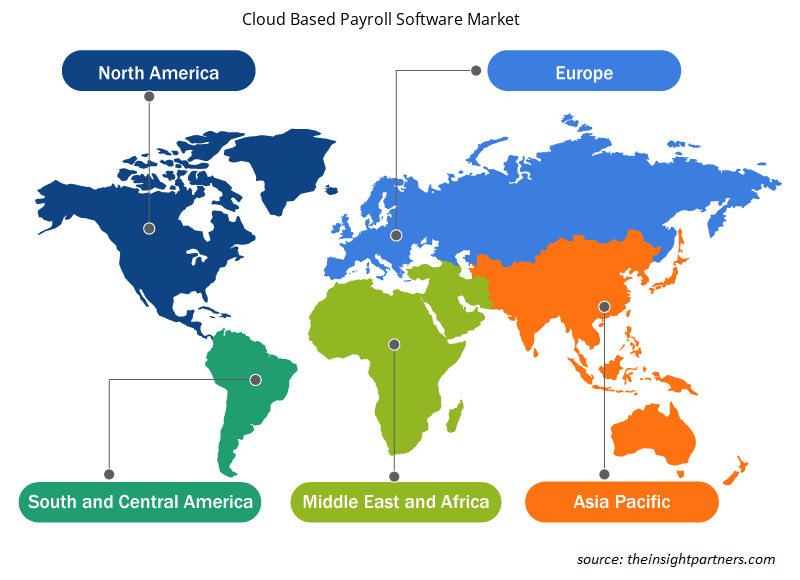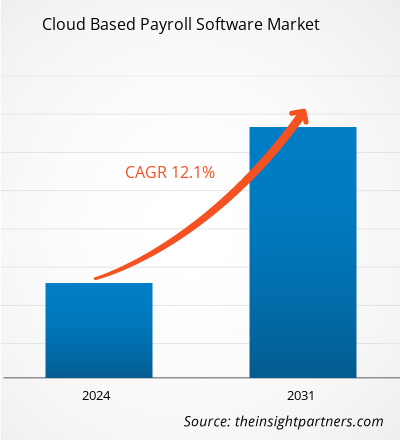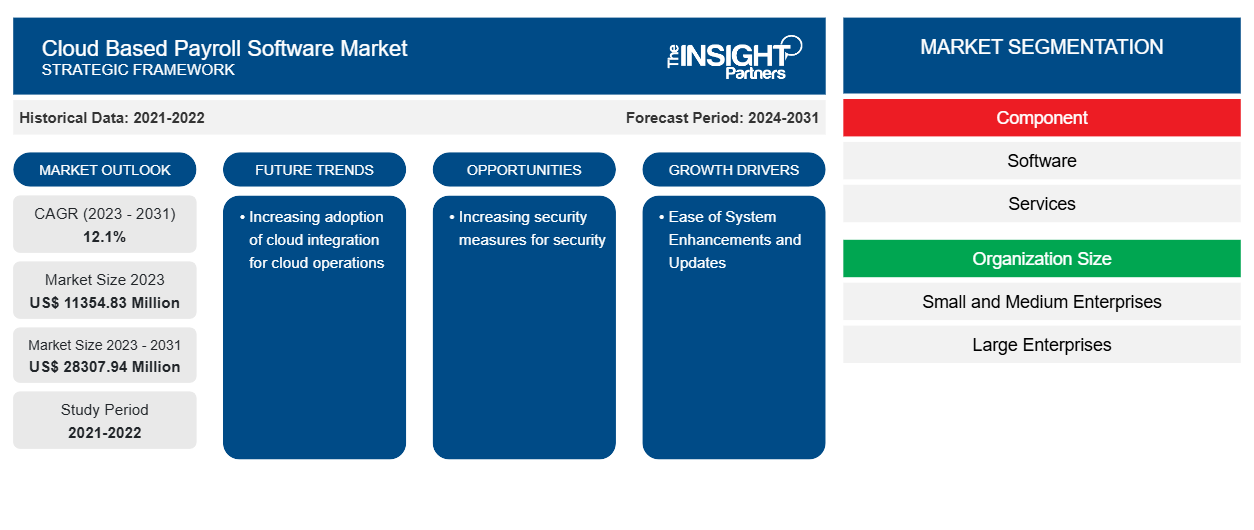Der Markt für cloudbasierte Lohn- und Gehaltsabrechnungssoftware soll von 11.354,83 Millionen US-Dollar im Jahr 2023 auf 28.307,94 Millionen US-Dollar im Jahr 2031 anwachsen. Der Markt soll zwischen 2023 und 2031 eine durchschnittliche jährliche Wachstumsrate (CAGR) von 12,1 % verzeichnen. Die zunehmende Nutzung der Cloud-Integration für Cloud-Operationen dürfte ein wichtiger Trend auf dem Markt bleiben.
Marktanalyse für cloudbasierte Lohn- und Gehaltsabrechnungssoftware
Ein Lohn- und Gehaltsabrechnungssystem ist für die Verwaltung und Kontrolle der Gehälter der Mitarbeiter zunehmend unverzichtbar geworden, und ein cloudbasiertes Lohn- und Gehaltsabrechnungssystem ist eine enorme Unterstützung für Organisationen, die remote arbeiten, einschließlich der Lohn- und Gehaltsabrechnungsabteilung. Cloudbasierte Lohn- und Gehaltsabrechnungssoftware sammelt, verwaltet und pflegt Mitarbeiterdaten, um die Zahlungen an Mitarbeiter aus der Ferne zu automatisieren. Darüber hinaus hilft sie Unternehmen, ihre Betriebskosten zu senken und gleichzeitig den neuesten finanziellen und rechtlichen Verpflichtungen gerecht zu werden. Durch den Einsatz cloudbasierter Lohn- und Gehaltsabrechnungssoftware können die Gehälter der Mitarbeiter von überall aus sicher ausgezahlt werden. Darüber hinaus können Unternehmen ihre Effizienz verbessern, indem sie neue Software mit geringerem internen Personalbedarf und minimalem Risiko einsetzen. Aufgrund des Kostenvermeidungsansatzes für die Verwaltung von Lohn- und Gehaltsabrechnungsvorgängen durch effektive Governance-Strukturen und die Einführung führender Praxisprozesse und -kontrollen wächst die Nachfrage nach cloudbasierter Lohn- und Gehaltsabrechnungssoftware mit der Expansion der BFSI- und IT- und Telekommunikationsbranche erheblich. Es wird erwartet, dass viele KMU die Nachfrage nach cloudbasierter Lohn- und Gehaltsabrechnungssoftware in den kommenden Jahren steigern werden. Daher wird erwartet, dass die wachsende Zahl von KMU in Zukunft lukrative Möglichkeiten für den Markt für cloudbasierte Lohn- und Gehaltsabrechnungssoftware bietet.
Marktübersicht für cloudbasierte Lohn- und Gehaltsabrechnungssoftware
Lohn- und Gehaltsabrechnungssoftware ist eine Cloud-basierte Plattform, die Zahlungen an Mitarbeiter verwaltet und automatisiert. Integrierte, robuste und richtig konfigurierte Lohn- und Gehaltsabrechnungssoftware kann Unternehmen jeder Größe dabei helfen, andere Finanzvorschriften und Steuergesetze einzuhalten und Kosten zu senken. Dies befreit Personalabteilungen von Routineaufgaben, sodass sie sich mehr auf Budgetierung, Planung und andere geschäftsfördernde Initiativen konzentrieren können. Einer der grundlegenden Vorteile von Cloud-basierten Lohn- und Gehaltsabrechnungssystemen besteht darin, dass Informationen von überall über ein mobiles oder Desktop-Computergerät abgerufen werden können.
Passen Sie diesen Bericht Ihren Anforderungen an
Sie erhalten kostenlos individuelle Anpassungen an jedem Bericht, einschließlich Teilen dieses Berichts oder einer Analyse auf Länderebene, eines Excel-Datenpakets sowie tolle Angebote und Rabatte für Start-ups und Universitäten.
-
Holen Sie sich die wichtigsten Markttrends aus diesem Bericht.Dieses KOSTENLOSE Beispiel umfasst eine Datenanalyse von Markttrends bis hin zu Schätzungen und Prognosen.
Treiber und Chancen auf dem Markt für cloudbasierte Lohn- und Gehaltsabrechnungssoftware
Einfache Systemverbesserungen und -aktualisierungen
Die Lohn- und Gehaltsabrechnung sollte effizient verwaltet werden, da Ungenauigkeiten bei der Berechnung und Verarbeitung der Lohn- und Gehaltsabrechnung die Erfahrung der Mitarbeiter im Unternehmen beeinträchtigen können. Darüber hinaus ist eine cloudbasierte Lohn- und Gehaltsabrechnungssoftware im Allgemeinen einfach einzurichten und zeitnah zu aktualisieren. Mitarbeiter können diese Software problemlos verwenden, und die Anbieter stellen auch einen Schulungsleitfaden zum Verständnis der Software zur Verfügung. Da die Software einfach zu installieren und zu aktualisieren ist, hat die Implementierung dieser Software erheblich zugenommen, um die Arbeit der Mitarbeiter zu erleichtern. Da Online-Lohn- und Gehaltsabrechnungssoftware einfach zu verwenden ist und eine schnelle Navigation ermöglicht, ermöglichen Anbieter von Lohn- und Gehaltsabrechnungssoftware den Endbenutzern, je nach Geschäftsanforderungen zu zahlen, indem sie die Anzahl der Benutzer erhöhen oder verringern. Finanzen sind ein entscheidendes Instrument für jedes Unternehmen, unabhängig von seiner Größe, Größe oder Branche. Um das Lohn- und Gehaltsabrechnungsmanagement zu verbessern, steigert die steigende Nachfrage nach Lohn- und Gehaltsabrechnungssoftware das Wachstum des Marktes für cloudbasierte Lohn- und Gehaltsabrechnungssoftware.
Erhöhung der Sicherheitsmaßnahmen für die Sicherheit
Sicherheit am Arbeitsplatz ist eine Voraussetzung, keine Option. Für Unternehmen ist es wichtiger denn je, der Sicherheit am Arbeitsplatz Priorität einzuräumen, wenn sie zu einem hybriden Arbeitsparadigma übergehen . Mit dem Aufkommen des digitalen Zeitalters ist die Häufigkeit von Datenschutzverletzungen und Cyberangriffen gestiegen. Sensible Daten werden teilweise durch Cybersicherheitstools wie Firewalls, Antivirenprogramme und verschlüsselte Kommunikationskanäle geschützt. Um zu gewährleisten, dass diese Systeme die neuesten Angriffe abwehren können, sind regelmäßige Updates erforderlich. Cloudbasierte Lohn- und Gehaltsabrechnungssoftware verfügt über eine Vielzahl von Sicherheitsfunktionen, die eine starke Barriere gegen die Bedrohung durch Datenfreigabe bilden. Sie ist eine Festung mit Multi-Faktor-Authentifizierung am Eingang, die wichtige Lohn- und Gehaltsdaten durch Verschlüsselung schützt. Daher eröffnen zunehmende Sicherheitsmaßnahmen verschiedene Möglichkeiten für den Markt.
Segmentierungsanalyse des Marktberichts für Cloud-basierte Gehaltsabrechnungssoftware
Wichtige Segmente, die zur Ableitung der Marktanalyse für cloudbasierte Lohn- und Gehaltsabrechnungssoftware beigetragen haben, sind Komponente, Organisationsgröße und Branche.
- Basierend auf den Komponenten ist der Markt für cloudbasierte Lohn- und Gehaltsabrechnungssoftware in Software und Dienstleistungen unterteilt. Das Softwaresegment hatte im Jahr 2023 einen größeren Marktanteil.
- Nach Unternehmensgröße ist der Markt in kleine und mittlere Unternehmen sowie Großunternehmen segmentiert. Das Segment der Großunternehmen hatte im Jahr 2023 einen größeren Marktanteil.
Nach Branchen ist der Markt in BFSI, Fertigung, Gesundheitswesen, IT und Telekommunikation, Einzelhandel, Gastgewerbe und andere segmentiert.
Marktanteilsanalyse für cloudbasierte Lohn- und Gehaltsabrechnungssoftware nach geografischen Gesichtspunkten
Der geografische Umfang des Marktberichts für cloudbasierte Lohn- und Gehaltsabrechnungssoftware ist hauptsächlich in fünf Regionen unterteilt: Nordamerika, Asien-Pazifik, Europa, Naher Osten und Afrika sowie Süd- und Mittelamerika.
Nordamerika dominiert den Markt für cloudbasierte Lohn- und Gehaltsabrechnungssoftware. Die USA hatten den größten Anteil am nordamerikanischen Markt für cloudbasierte Lohn- und Gehaltsabrechnungssoftware. Verschiedene Unternehmen in den USA setzen zunehmend fortschrittliche Lohn- und Gehaltsabrechnungslösungen für das Personalmanagement ein . Die Verwendung veralteter Lohn- und Gehaltsabrechnungssysteme wie Tabellenkalkulationen hat aufgrund der zunehmenden Beliebtheit automatisierter Lohn- und Gehaltsabrechnungsprozesse auf Basis eines zentralisierten Systems abgenommen. Diese Prozesse helfen ihnen, Compliance-Standards einzuhalten. Für Personalabteilungen war es eine schwierige Aufgabe, Lohn- und Gehaltsabrechnungsprozesse manuell zu verwalten.
Regionale Einblicke in den Markt für cloudbasierte Lohn- und Gehaltsabrechnungssoftware
Die regionalen Trends und Faktoren, die den Markt für cloudbasierte Lohn- und Gehaltsabrechnungssoftware während des Prognosezeitraums beeinflussen, wurden von den Analysten von Insight Partners ausführlich erläutert. In diesem Abschnitt werden auch die Marktsegmente und die Geografie von cloudbasierter Lohn- und Gehaltsabrechnungssoftware in Nordamerika, Europa, im asiatisch-pazifischen Raum, im Nahen Osten und Afrika sowie in Süd- und Mittelamerika erörtert.

- Erhalten Sie regionale Daten zum Markt für cloudbasierte Lohn- und Gehaltsabrechnungssoftware
Umfang des Marktberichts zur cloudbasierten Gehaltsabrechnungssoftware
| Berichtsattribut | Details |
|---|---|
| Marktgröße im Jahr 2023 | 11354,83 Millionen US-Dollar |
| Marktgröße bis 2031 | 28307,94 Millionen US-Dollar |
| Globale CAGR (2023 - 2031) | 12,1 % |
| Historische Daten | 2021-2022 |
| Prognosezeitraum | 2024–2031 |
| Abgedeckte Segmente |
Nach Komponente
|
| Abgedeckte Regionen und Länder |
Nordamerika
|
| Marktführer und wichtige Unternehmensprofile |
|
Dichte der Marktteilnehmer für cloudbasierte Lohn- und Gehaltsabrechnungssoftware: Auswirkungen auf die Geschäftsdynamik verstehen
Der Markt für Cloud-basierte Lohn- und Gehaltsabrechnungssoftware wächst rasant. Dies wird durch die steigende Nachfrage der Endnutzer aufgrund von Faktoren wie sich entwickelnden Verbraucherpräferenzen, technologischen Fortschritten und einem größeren Bewusstsein für die Vorteile des Produkts vorangetrieben. Mit der steigenden Nachfrage erweitern Unternehmen ihr Angebot, entwickeln Innovationen, um die Bedürfnisse der Verbraucher zu erfüllen, und nutzen neue Trends, was das Marktwachstum weiter ankurbelt.
Die Marktteilnehmerdichte bezieht sich auf die Verteilung der Firmen oder Unternehmen, die in einem bestimmten Markt oder einer bestimmten Branche tätig sind. Sie gibt an, wie viele Wettbewerber (Marktteilnehmer) in einem bestimmten Marktraum im Verhältnis zu seiner Größe oder seinem gesamten Marktwert präsent sind.
Die wichtigsten Unternehmen auf dem Markt für Cloud-basierte Lohn- und Gehaltsabrechnungssoftware sind:
- Die Sage Group plc
- Moorepay Limited
- Automatische Datenverarbeitung, Inc.
- Xero Limited
- Ceridian HCM, Inc
- MYOB Australia Pty Ltd
Haftungsausschluss : Die oben aufgeführten Unternehmen sind nicht in einer bestimmten Reihenfolge aufgeführt.

- Überblick über die wichtigsten Akteure auf dem Markt für cloudbasierte Lohn- und Gehaltsabrechnungssoftware
Neuigkeiten und aktuelle Entwicklungen zum Markt für cloudbasierte Lohn- und Gehaltsabrechnungssoftware
Der Markt für cloudbasierte Lohn- und Gehaltsabrechnungssoftware wird durch die Erfassung qualitativer und quantitativer Daten nach Primär- und Sekundärforschung bewertet, die wichtige Unternehmenspublikationen, Verbandsdaten und Datenbanken umfasst. Nachfolgend sind einige der Entwicklungen auf dem Markt für cloudbasierte Lohn- und Gehaltsabrechnungssoftware aufgeführt:
- Oracle hat Pläne angekündigt, Oracle Payroll für Irland bereitzustellen, einen Teil von Oracle Fusion Cloud Human Capital Management (HCM). Die neue Lokalisierung baut auf der Leistungsfähigkeit der globalen Gehaltsabrechnungslösung von Oracle auf und bietet intelligente Funktionen wie KI-gesteuerte Risikominderung, automatisierte Arbeitsabläufe, integrierte Compliance-Unterstützung, verbesserte Dateneinblicke und schnelle Gehaltsabrechnungsprozesse für in Irland tätige Mitarbeiter. (Quelle: Oracle, Pressemitteilung, März 2024)
- Ramco Systems gab die Einführung von Ramco Payce bekannt, einer plattformbasierten Lohn- und Gehaltsabrechnungssoftware, die die Art und Weise, wie Unternehmen ihre Lohn- und Gehaltsabrechnung verwalten, neu definieren soll. Payce nutzt fortschrittliche Technologien wie serverloses In-Memory, künstliche Intelligenz, Datenanalyse und maschinelles Lernen. Ramcos zwei Jahrzehnte außergewöhnlicher Leistung helfen Unternehmen dabei, die Lohn- und Gehaltsabrechnung schneller, müheloser und präziser abzuwickeln. (Quelle: Ramco Systems, Pressemitteilung, Februar 2024)
Marktbericht zu cloudbasierter Lohn- und Gehaltsabrechnungssoftware – Umfang und Ergebnisse
Der Bericht „Marktgröße und Prognose für cloudbasierte Lohn- und Gehaltsabrechnungssoftware (2021–2031)“ bietet eine detaillierte Analyse des Marktes, die die folgenden Bereiche abdeckt:
- Marktgröße und Prognose für Cloud-basierte Lohn- und Gehaltsabrechnungssoftware auf globaler, regionaler und Länderebene für alle wichtigen Marktsegmente, die im Rahmen des Berichts abgedeckt sind
- Markttrends für cloudbasierte Lohn- und Gehaltsabrechnungssoftware sowie Marktdynamiken wie Treiber, Einschränkungen und wichtige Chancen
- Detaillierte PEST/Porters Five Forces- und SWOT-Analyse
- Marktanalyse für cloudbasierte Lohn- und Gehaltsabrechnungssoftware mit Angaben zu den wichtigsten Markttrends, globalen und regionalen Rahmenbedingungen, wichtigen Akteuren, Vorschriften und aktuellen Marktentwicklungen
- Branchenlandschaft und Wettbewerbsanalyse, die die Marktkonzentration, Heatmap-Analyse, prominente Akteure und aktuelle Entwicklungen für den Markt für Cloud-basierte Lohn- und Gehaltsabrechnungssoftware umfasst
- Detaillierte Firmenprofile
- Historische Analyse (2 Jahre), Basisjahr, Prognose (7 Jahre) mit CAGR
- PEST- und SWOT-Analyse
- Marktgröße Wert/Volumen – Global, Regional, Land
- Branchen- und Wettbewerbslandschaft
- Excel-Datensatz
Aktuelle Berichte
Verwandte Berichte
Erfahrungsberichte
Grund zum Kauf
- Fundierte Entscheidungsfindung
- Marktdynamik verstehen
- Wettbewerbsanalyse
- Kundeneinblicke
- Marktprognosen
- Risikominimierung
- Strategische Planung
- Investitionsbegründung
- Identifizierung neuer Märkte
- Verbesserung von Marketingstrategien
- Steigerung der Betriebseffizienz
- Anpassung an regulatorische Trends























 Kostenlose Probe anfordern für - Markt für cloudbasierte Lohn- und Gehaltsabrechnungssoftware
Kostenlose Probe anfordern für - Markt für cloudbasierte Lohn- und Gehaltsabrechnungssoftware